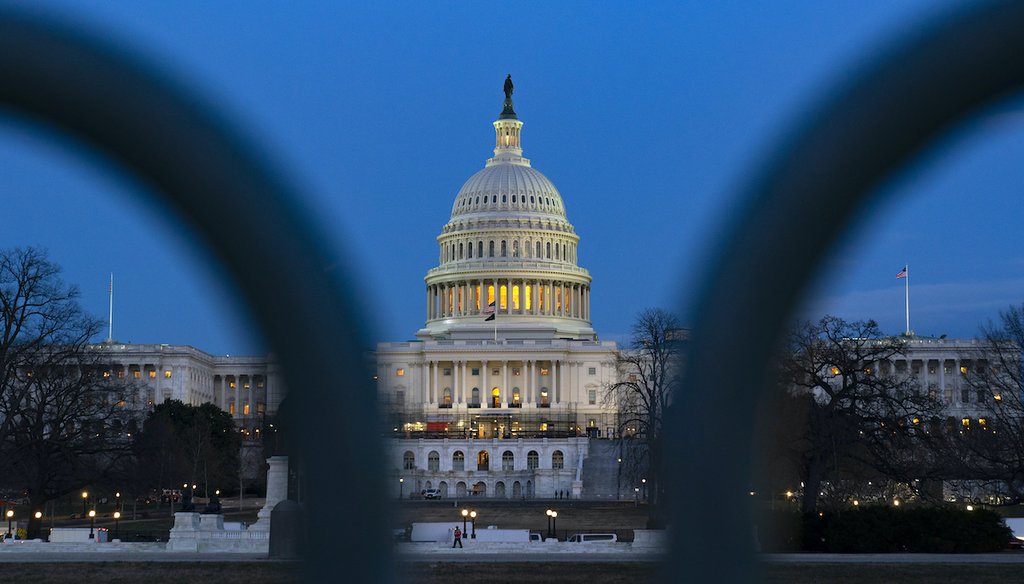Stand up for the facts!
Our only agenda is to publish the truth so you can be an informed participant in democracy.
We need your help.
I would like to contribute

Barricades surround the U.S. Capitol at sunset before the State of the Union, Tuesday, March 1, 2022, in Washington. (AP)
If Your Time is short
We also fact-checked the GOP response from Iowa Gov. Kim Reynolds.
President Joe Biden argued forcefully for the power of democracy while calling out Russia’s invasion of Ukraine in a State of the Union address that soon turned to the domestic concerns of the economy, inflation and COVID-19.
PolitiFact’s team of reporters and editors watched the March 1 address and fact-checked some of the president’s remarks.
Hear something that stood out to you? Send us an email at truthometer@politifact.com.
Biden condemned Vladimir Putin’s use of force against Ukraine in his speech while touting the strength of the Ukrainian people as well as the NATO alliance, formed after World War II, that shared intelligence and cracked down on Russia’s oligarchs, banking system and airlines to isolate Putin. When Biden introduced Ukrainian ambassador Oksana Markarova, standing in the gallery with first lady Jill Biden, the room responded with a standing ovation.
"We countered Russia’s lies with the truth. And now that he has acted, the free world is holding him accountable," Biden said.
Sign up for PolitiFact texts
Biden’s one-hour speech was given to a largely unmasked crowd of lawmakers, justices and Cabinet members in the House chamber, another sign of the diminished threat of the omicron variant. Biden said the nation was entering a phase where "COVID-19 need no longer control our lives," though the U.S. should stay on guard by expanding vaccines, treatments and testing and monitoring new variants.
We fact-checked several claims — and addressed his flub of the word "Ukrainian" — that Biden made about foreign policy, the state of the U.S. economy, and arguments he made for a new "unity agenda."
RUSSIA
"Putin’s latest attack on Ukraine was premeditated and totally unprovoked."
This is accurate. Russia’s attack on Ukraine stands out as an unusually stark violation of the rules of the post-World War II era.
It was common prior to World War II for great powers to invade their neighbors or colonize other countries. But after the war ended in 1945, the victorious powers established a system of international organizations and laws that, while imperfect, have tended to clamp down on the most naked forms of aggression.
In this context, the invasion of Ukraine "seems to be an extremely clear violation of Article 2, Paragraph 4 of the United Nations Charter," Anthony Clark Arend, a professor of government and foreign service at Georgetown University, told PolitiFact. This section of the charter says that "all members shall refrain … from the threat or use of force against the territorial integrity or political independence of any state."
The invasion Putin launched targeted a sovereign neighbor that had not threatened them militarily. And his presumed endgame is full-scale annexation of the entirety of Ukraine.
"Putin has hinted at wanting to ‘restore’ Russian or Soviet borders and questioned the legitimacy of Ukraine as a state," said Tanisha M. Fazal, a University of Minnesota political scientist.
"Putin may circle Kyiv with tanks, but he'll never gain the hearts and souls of the Iranian people."
Biden misspoke. The prepared remarks for Biden’s speech distributed before he spoke showed that he meant to refer to the Ukrainian people, not Iranians. Interestingly, the flub does keep a streak alive — Iran has been mentioned at every State of the Union since President Bill Clinton’s final State of the Union address in January 2000.
The U.S. economy
"Our economy created over 6.5 million new jobs just last year, more jobs in one year than ever before in the history of the United States of America."
We rated this Half True.
He has a point about the raw number of jobs created and the fact that it was bigger than any previous year for which data is available. But as the U.S. population has grown, so has the labor force.
Using the annual percentage increase of job gains, 2021 put up strong numbers but did not set an all-time record.
The number of jobs in 2021 increased by about 4.4%, which was the highest percentage since 1979. Still, going back to 1940, the percentage increase seen in 2021 was exceeded 10 times.
"By the end of this year, the deficit will be down to less than half what it was before I took office. The only president ever to cut the deficit by more than $1 trillion in a single year."
The math is correct based on projections, but this leaves out important context about exactly how big recent deficits have been.
According to the Congressional Budget Office, the deficit at the end of 2020 was $3.129 trillion, because of the pandemic-driven economic collapse and historic government spending to cushion the blow.
At the end of 2022, the CBO estimates the deficit will be $1.153 trillion. That’s about 36% of the deficit two years before.
But the deficits since 2020 are off-the-charts high. The last time the deficit cracked the trillion dollar mark was in 2009 during the Great Recession. So, it’s not surprising that no other president has overseen a deficit reduction of over $1 trillion. The CBO predicts that deficits will begin to rise after 2024.
COVID-19
"Under the new guidelines, most Americans and most of the country can now go mask-free. And based on projections, more of the country will (cross) this point in the next couple of weeks."
This is accurate. Under the CDC’s updated guidelines released Feb. 25, about 70% of Americans live in low-to-medium COVID-19 risk areas and will be allowed to go out in public and indoor spaces maskless.
The agency considers counties to be at high risk if they are recording 200 or more new infections for every 100,000 people, or if 10% or more of hospital beds have been occupied by COVID-19 patients in the past seven days. An area is also deemed high risk if 10 or more people for every 100,000 residents are being admitted to hospitals for the disease.
Under the new rules, residents of high-risk areas will have to mask up. In medium-risk communities, however, masks are recommended only for those who are immunocompromised. In communities with low levels of COVID-19, there is no recommendation to wear a mask.
Also, recent CDC projections for the next four weeks suggest continued drops in hospitalizations and deaths. If that trend actually plays out, then more Americans will be able to go maskless.
"Seventy-five percent of adult Americans are fully vaccinated, and hospitalizations are down by 77%. Most Americans can remove their masks and stay in the classroom and move forward safely."
This is a largely accurate description of official numbers and guidance. According to the CDC, as of March 1, 75% of Americans 18 years or older are fully vaccinated, or 193,643,363 people.
It’s unclear what is the starting point of Biden’s claim that COVID-19 related hospitalizations are down by 77%, but about 60,000 people with the coronavirus are hospitalized nationally, down from about 160,000 in January according to New York Times data. This translates to a 62.5% drop.
Additionally, it is accurate that most Americans are not required to wear a mask under the CDC’s updated guidelines released Feb. 25.
Domestic agenda
The liability shield "makes gun manufacturers the only industry in America that can’t be sued, the only one."
This is False.
Congress has passed other laws that protect a variety of business sectors from lawsuits in certain situations, so this type of law isn’t unique to the gun industry.
The law that protects gunmakers is the 2005 Protection of Lawful Commerce in Arms Act. The law’s purpose is to generally protect gun dealers and manufacturers from lawsuits for shooting deaths. But the law lists six exceptions where lawsuits can occur. It does not protect gun dealers who transfer a gun knowing it would be used for criminal purposes, nor those who knowingly break state or federal law if the violation results in harm. Gun manufacturers can also be sued if the gun, when used properly, causes injury because the product is defective.
The act "provides incredibly robust protections of a kind that almost no other sector gets, but it’s true that it does not mean the gun industry can’t be sued," said Jake Charles, executive director of Duke’s Center for Firearms Law.
Biden’s claim this evening "was just as wrong" as Hillary Clinton's almost identical statement in 2015, Walter Olson, a senior fellow at the Cato Institute, told PolitiFact.
"Under my plan, nobody earning less than $400,000 a year will pay an additional penny in new taxes. Not a single penny."
Taken at face value, this statement is accurate. Biden’s plans do not include direct tax increases on households with less than $400,000 of annual income. But Biden has proposed higher taxes on corporations.
Critics say that raising corporate taxes would break his promise, because corporate taxes are at least partially passed along to ordinary Americans in the form of lower wages and lower stock values.
However, many tax experts caution that the impact of corporate tax increases on individual taxpayers is indirect and hard to quantify, so much so that different analyses use a variety of mechanisms to figure out the scale of the impact.
"The $2 trillion tax cut passed in the previous administration … benefited the top 1% of Americans."
Biden has a point, but his claim omits tax benefits for other income groups.
The benefits of the tax cut signed by then-President Donald Trump have flowed disproportionately to wealthier taxpayers. However, every income group was poised to pay less in taxes, at least in the legislation’s first few years of existence.
The imbalance of benefits going to the top 1% is set to increase with time, reaching 83% by 2027, due largely to the eventual expiration of several middle-income tax cuts.
"Our infrastructure is ranked 13th in the world."
This is correct, based on a commonly used report.
In 2019, the World Economic Forum reported that using a broad measure of infrastructure quality, the United States ranked 13th globally. (Singapore was No. 1.) The study looked more at how well the country’s roads, airports and railroads functioned, rather than their state of repair. It also factored in the fraction of the population exposed to unsafe drinking water, and in that sub-category, the U.S. ranked 14th.
A different assessment by the American Society of Civil Engineers in 2021 gave the country’s infrastructure an overall grade of C minus.
For decades, local, state and federal officials have warned that the United States is failing to put enough money into its roads, bridges, and water mains.
"There’s been a law on the books for almost a century to make sure taxpayers’ dollars support American jobs and businesses. Every administration says they’ll do it, Democrat and Republican, but we are actually doing it."
This is a fair description of the law. But there are still some loopholes to watch.
Since 1933, in the depths of the Great Depression, the U.S. has had the Buy American Act. It requires the federal government to buy American-made goods whenever possible. But there are waivers and exceptions.
In his first week in office, Biden signed an executive order to reduce the loopholes that allow government agencies to buy foreign-made goods. Waivers will remain, but legal advisers to companies that sell to the government expect that getting a waiver will become harder.
Another aspect of the executive order concerns the rules for defining what counts as a domestically made product. Biden has moved to tighten those rules, too. But that’s not a guarantee that every bit of every product the government buys will be made in the U.S.
"The American Rescue Plan is helping millions of families on Affordable Care Act plans save $2,400 a year on their health care premiums."
This is accurate. The American Rescue Plan expanded subsidies for marketplace health insurance plans to many Americans – more than 3 million — who didn’t previously qualify for them.
The subsidies meant Affordable Care Act insurance premiums for many families were much lower. The Department of Health and Human Services estimated that for four in five enrollees, it would cost $10 or less a month to sign up for health insurance.
The $2,400 per year savings appears to be derived from a 2021 Health and Human Services press release that described examples of how rescue plan subsidies will save money, such as: "A family of four making $90,000 will see their premiums decrease by $200 per month." That would calculate out to $2,400 per year.
Estimates from other organizations also support savings in this number range. According to KFF, a nonprofit health policy organization, individual consumers on average could save $70 per month on health insurance because of the American Rescue Plan subsidies. For a family of three, that would translate to a savings of $210 per month or about $2,500 per year. But, not all kids would necessarily automatically qualify for Affordable Care Act coverage — many instead qualify for the Children’s Health Insurance Program, called CHIP.
Still, KFF’s 2021 subsidy calculator shows that a 40-year old couple with two kids who make 200% of the poverty level (in the mid-range of income) would get $16,247 per year in subsidies. Compared to a KFF subsidy calculator dating back before the American Rescue Plan, that same family would receive $13,878 in subsidies. That's exactly a $2,369 difference in savings.
"So, the $2,400 does seem very reasonable," said Cynthia Cox, vice President and director for the program on the ACA at KFF.
PolitiFact reporters Jon Greenberg, Louis Jacobson and Amy Sherman and Kaiser Health News reporters Victoria Knight and Colleen DeGuzman contributed to this report.
RELATED: State of PolitiFact 2022: The stakes are high for democracy and fact-checking
RELATED: The state of the pandemic after two years, in charts
Our Sources
See links in the story.
World Economic Forum, The Global Competitiveness Report - 2019, 2019
American Society of Civil Engineers, Report card for America’s infrastructure, 2021
PolitiFact, Stefanik catches Cuomo misstating law on gun industry liability, Aug. 13, 2021
PolitiFact, Clinton: Gun industry is ‘wholly protected’ from all lawsuits Oct 16, 2015
FactCheck.org,"Biden’s Missteps on Gun Policies," April 8, 2021
Email interview, Walter Olson, senior fellow at the Cato Institute, March 1, 2022
Congressional Budget Office, Updated Budget and Economic Outlook: 2021 to 2031: Deficits, July 2021
FRED, Federal surplus or deficit, accessed March 1, 2022





































